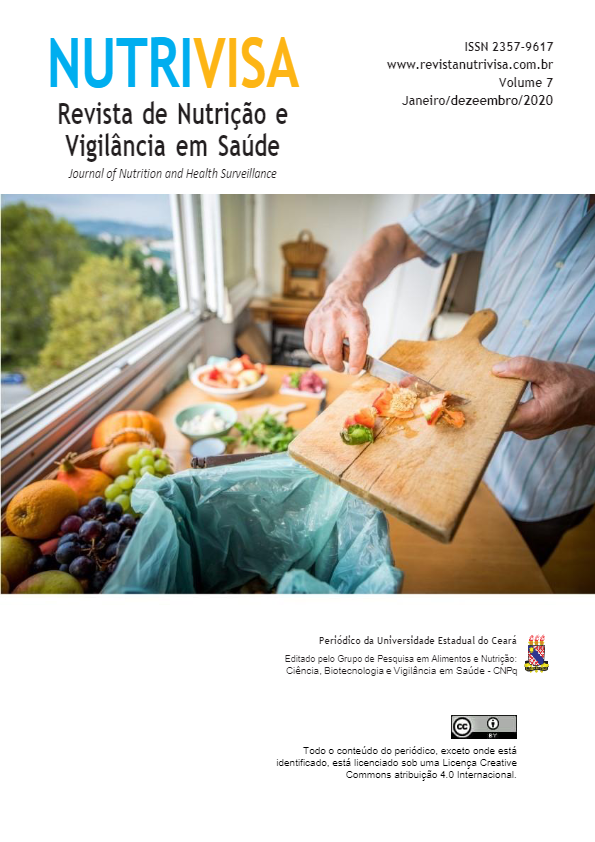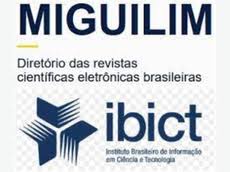Chemical characteristics and cytotoxicity of camu-camu pectin [Myrciaria dubia (H.B.K.) Mcvaugh]
DOI:
https://doi.org/10.59171/nutrivisa-2020v7e13741Keywords:
Neoplasms. Pectins. Myrciaria dubia. Toxicity tests. Microbial Sensitivity Tests.Abstract
The aim of this study was to characterize the chemical structure and toxicity of pectin from camu-camu (Myrciaria dubia H. B. K. (McVough). Its chemical structure was analyzed by absorption spectroscopy in the infrared region (FT-IR), hydrogen and carbon nuclear magnetic resonance (1H NMR and 13C NMR), elemental analysis (EA), exploratory scanning calorimetry (DSC) and thermogravimetric analysis (TGA/DTG), as well as toxicity assay in human neutrophils. Hydroxyl groups, α-D-galacturonic, β-D-galactopyranosyl, Arabinose, methylated L-rhamnose, CH2 groups, esterified and free methyl carboxylic groups, acetyl groups, carboxylate groups and pyranoside ring, as well as a degree of methoxylation between 40.8 and 44.7%, were identified. EA indicated the presence of sodium and nitrogen at 1.88%, and degradation occurred above 240ºC. There was no toxicity of pectin in neutrophils. It was concluded that camu-camu pectin presented a low degree of methoxylation and absence of toxicity to neutrophils, enabling its biotechnological use.
References
AKTER, M. S.; OH, S.; EUN, J.; AHMED, M. Nutritional compositions and health promoting phytochemicals of camu-camu (myrciaria dubia) fruit: A review. Food Research International, v. 44, n. 7, p. 1728–1732, 2011.
AZEVÊDO, J. C. S.; FUJITA, A.; OLIVEIRA, E. L. de; GENOVESE, M. I.; CORREIA, R. T. P. Dried camu-camu (Myrciaria dubia H.B.K. McVaugh) industrial residue: A bioactive-rich Amazonian powder with functional attributes. Food Research International, v. 62, p. 934–940, 2014.
BEAULIEU, M.; TURGEON, S. L.; DOUBLIER, J. -L. Rheology, texture and microstructure of whey proteins/low methoxyl pectins mixed gels with added calcium. International Dairy Journal, v. 11, n. 11–12, p. 961–967, 2001.
BELCHEVA, A.; MARTIN, A. Gut microbiota and colon cancer: the carbohydrate link. Molecular & Cellular Oncology, v. 2, n. 1, p. 1–2, 2015.
BEZERRA, T.S.; FERNANDES, T.N.; RESENDE, J.V. Effects of added sucrose and pectin on the rheological behavior and freezing kinetics of passion fruit pulp Studied by response surface methodology. Journal of Food Science and Technology, v. 52, n. 6, p. 3350–3357, 2014.
BINDELS, L. B.; THISSEN, J.P. Nutrition in cancer patients with cachexia: A role for the gut microbiota? Clinical Nutrition Experimental, v. 6, p. 74–82, 2016.
CANTERI, M.H.G; MORENO, L.; WOSIACKI, G.; SCHEER, A.P. Pectina: da matéria-prima ao produto final. Polímeros, vol. 22, n. 2, p. 149-157, 2012.
CHAN, F. K.M.; MORIWAKI, K.; ROSA, M.J. Detection of Necrosis by Release of Lactate Dehydrogenase Activity. In: SNOW, A. L.; LENARDO, M. J. (Eds.). Immune Homeostasis: methods and protocols. Nova Iorque: Humana Press, 2013.
CHIRINOS, R.; GALARZA, J.; BETALLELUZ-PALLARDEL, I.; PEDRESCHI, R.; CAMPOS, D. Antioxidant compounds and antioxidant capacity of Peruvian camu camu (Myrciaria dubia (H.B.K.) McVaugh) fruit at different maturity stages. Food Chemistry, v. 120, n. 4, p. 1019–1024, 2010.
CONCEIÇÃO, M.C.; FERNANDES, T.N.; RESENDE, J.V. Stability and microstructure of freeze-dried guava pulp (Psidium guajava L.) with added sucrose and pectin. Journal of Food Science and Technology, v. 53, n. 6, p. 2654–2663, 2016.
EINHORN-STOLL, U.; KUNZEK, H. Thermoanalytical characterisation of processing-dependent structural changes and state transitions of citrus pectin. Food Hydrocolloids, v. 23, n. 1, p. 40–52, 2009.
EUROPEAN FOOD SAFETY AUTHORITY. Health Claims on Pectins Approved by EFSA. EFSA Journal, v. 8, n. 10, p. 1747–1753, 2010.
FUJITA, A.; BORGES, K.; CORREIA, R.; FRANCO, B.D. G.M.; GENOVESE, M.I. Impact of spouted bed drying on bioactive compounds, antimicrobial and antioxidant activities of commercial frozen pulp of camu-camu (Myrciaria dubia Mc. Vaugh). Food Research International, v. 54, n. 1, p. 495–500, 2013.
FUJITA, A.; SARKAR, D.; WU, S.; KENNELLY, E.; SHETTY, K.; GENOVESE, M. I. Evaluation of phenolic-linked bioactives of camu-camu (Myrciaria dubia Mc. Vaugh) for antihyperglycemia, antihypertension, antimicrobial properties and cellular rejuvenation. Food Research International, v. 77, p. 194–203, 2015.
GHAFFARI, A.; NAVAEE, K. OSKOUI, M.; BAYATI, K.; RAFIEE-TEHRANI, M. Preparation and characterization of free mixed-film of pectin/chitosan/Eudragit RS intended for sigmoidal drug delivery. European Journal of Pharmaceutics and Biopharmaceutics, v. 67, n. 1, p. 175–186, 2007.
INOUE, T.; KOMODA, H.; UCHIDA, T.; NODE, K. Tropical fruit camu-camu (Myrciaria dubia) has anti-oxidative and anti-inflammatory properties. Journal of Cardiology, v. 52, n. 2, p. 127–132, 2008.
INSTITUTO NACIONAL DE PESQUISAS DA AMAZÔNIA. Cultivo do Camu-Camu. Disponível em: <https://www.inpa.gov.br/cpca/areas/camu-camu.html>. Acesso em: 25 ago. 2015.
JIANG, T.; GAO, X.; WU, C.; TIAN, F.; LEI, Q.; BI, J.; XIE, B.; WANG, H. Y.; CHEN, S.; WANG, X. Apple-derived pectin modulates gut microbiota, improves gut barrier function, and attenuates metabolic endotoxemia in rats with diet-induced obesity. Nutrients, v. 8, n. 3, p. 1–20, 2016.
JUSTI, K. C.; VISENTAINER, J. V.; SOUZA, N. E. de; MATSUSHITA, M. Nutritional composition and vitamin C stability in stored camu-camu (Myrciaria dubia) pulp. Archivos latinoamericanos de nutrición, v. 50, n. 4, p. 405–8, 2000.
KHAMSUCHARIT, P.; LAOHAPHATANALERT, K.; GAVINLERTVATANA, P.; SRIROTH, K.; SANGSEETHONG, K. Characterization of pectin extracted from banana peels of different varieties. Food Sci Biotechnol. v.27, n.3, p.623–629, 2017.
KOUBALA, B.B.; KANSCI, G.; MBOME, L.I.; CRÉPEAU, M.J.; THIBAULT, J.F.; RALET, M. C. Effect of extraction conditions on some physicochemical characteristics of pectins from “Améliorée” and “Mango” mango peels. Food Hydrocolloids, v. 22, n. 7, p. 1345–1351, 2008.
LANGLEY, P.C.; JUNIOR, J.V.P.; JUNIOR, R.T.; RIDGWAY, C. Antioxidant and Associated Capacities of Camu Camu (Myrciaria dubia): A Systematic Review. The Journal of Alternative and Complementary Medicine, v. 21, n. 1, p. 8–14, 2015.
LEÃO, D.P.; BOTELHO, B.G.; OLIVEIRA, L.S.; FRANCA, A.S. Potential of pequi (Caryocar brasiliense Camb.) peels as sources of highly esterified pectins obtained by microwave assisted extraction. LWT - Food Science and Technology. v.87, p.575-580, 2018.
LIU, J.; WILLFÖR, S.; XU, C. A review of bioactive plant polysaccharides: Biological activities, functionalization, and biomedical applications. Bioactive Carbohydrates and Dietary Fibre, v. 5, n. 1, p. 31–61, 2015.
LOPES, A.A.; MAGALHÃES, T.R.; UCHÔA, D.E.A.; SILVEIRA, E.R.; AZZOLINI, A.E.C.S.; KABEYA, L.M.; LUCISANO-VALIM, Y.M.; VASCONCELOS, S.M.M.; VIANA, G.S.B.; LEAL, L.K.A.M. Afrormosin, an Isoflavonoid from Amburana cearensis A. C.Smith, Modulates the Inflammatory Response of StimulatedHuman Neutrophils. Basic & Clinical Pharmacology & Toxicology, V.113, P.363–369, 2013.
MAXWELL, E. G.; BELSHAW, N. J.; WALDRON, K. W.; MORRIS, V. J. Pectin – An emerging new bioactive food polysaccharide. Trends in Food Science & Technology, v. 24, n. 2, p. 64–73, 2012.
MIN, B.; KOO, O.K.; PARK, S.H.; JARVIS, N.; RICKE, S.C.; CRANDALL, P.G.; LEE, S.O. Fermentation patterns of various pectin sources by human fecal microbiota. Food and Nutrition Sciences, v. 6, n. 12, p. 1103–1114, 2015.
NASCIMENTO, O.V.; BOLETI, A. P.A.; YUYUMA, L.K.O.; LIMA, E.S. Effects of diet supplementation with Camu-camu (Myrciaria dubia HBK McVaugh) fruit in a rat model of diet-induced obesity. Anais da Academia Brasileira de Ciencias, v. 85, n. 1, p. 355–363, 2013.
NGUYEN, B.M.N.; PIRAK, T. Physicochemical properties and antioxidant activities of white dragon fruit peel pectin extracted with conventional and ultrasound-assisted extraction. Cogent Food & Agriculture. v.5, n.1, 2019.
OLANO-MARTIN, E.; RIMBACH, G.H.; GIBSON, G.R.; RASTALL, R. A. Pectin and pectic-oligosaccharides induce apoptosis in in vitro human colonic adenocarcinoma cells. Anticancer Research, v. 23, n. 1A, p. 341–346, 2003.
PHUONG, H.M.K.; HOA, N.D.H.; HA, N.V.H. Effects of added pectin amounts and drying temperatures on antioxidant properties of mulberry fruit leather. Journal of Biotechnology, v. 14, n. 1A, p. 487–495, 2016.
RODRIGUEZ-GARCIA, I.; CRUZ-VALENZUELA, M.R.; SILVA-ESPINOZA, B.A.; GONZALEZ-AGUILAR, G.A.; MOCTEZUMA, E.; GUTIERREZ-PACHECO, M.M.; TAPIA-RODRIGUEZ, M.R.; ORTEGA-RAMIREZ, L.A.; AYALA-ZAVALA, J.F. Oregano (Lippia graveolens) essential oil added within pectin edible coatings prevents fungal decay and increases the antioxidant capacity of treated tomatoes. Journal of the Science of Food and Agriculture, v. 96, p. 3772–3778, 2016.
ROSENBOHM, C.; LUNDT, I.; CHRISTENSEN, T.M.I.E.; YOUNG, N.W.G. Chemically methylated and reduced pectins: Preparation, characterisation by 1H NMR spectroscopy, enzymatic degradation, and gelling properties. Carbohydrate Research, v. 338, n. 7, p. 637–649, 2003.
SILVA, D.C.; FREITAS, A. L. P.; PESSOA, C.D.S.; PAULA, R.C.M.; MESQUITA, J. X.; LEAL, L.K.A. M.; BRITO, G.A.C.; GONÇALVES, D.O.; VIANA, G.S.B. Pectin from Passiflora edulis shows Anti-inflammatory Action as well as Hypoglycemic and Hypotriglyceridemic Properties in Diabetic Rats. Journal of Medicinal Food, v. 14, n. 10, p. 1118–1126, 2011.
SOUSA, R.V.R.B.; GUEDES, M.I.F.; MARQUES, M.M.M.; VIANA, D.A.; SILVA, I. N. G.; RODRIGUES, P.A.S.; VIEIRA, I.G.P. Hypoglycemic Effect of New Pectin Isolated From Passiflora Glandulosa Cav in Alloxan-Induced Diabetic Mice. World Journal of Pharmacy and Pharmaceutical Sciences, v. 4, n. 1, p. 1571–1586, 2015.
TUNG, N.T.; PHAM, T.M.H.; NGUYEN, T.H.; PHAM, T.T.; NGUYEN, T.Q. Pectin/HPMC dry powder coating formulations for colon specific targeting tablets of metronidazole. Journal of Drug Delivery Science and Technology, v. 33, p. 19–27, 2016.
VIERA, V.B.; RODRIGUES, J.B.; BRASIL, C.C.B.; ROSA, C.S. Produção, caracterização e aceitabilidade de licor de camu-camu (Myrciaria dúbia (H. B. K.) MCVAUGH). Alimentos e Nutrição, v. 21, n. 4, p. 519–522, 2010.
VILLANUEVA-TIBURCIO, J.E.; CONDEZO-HOYOS, L.A.; ASQUIERI, E.R. Antocianinas, ácido ascórbico, polifenoles totales y actividad antioxidante, en la cáscara de camu-camu (Myrciaria dubia (H.B.K) McVaugh). Ciência e Tecnologia de Alimentos, v. 30, n. Supl. 1, p. 151–160, 2010.
VORAGEN, A.G.J.; COENEN, G.J.; VERHOEF, R.P.; SCHOLS, H.A. Pectin, a versatile polysaccharide present in plant cell walls. Structural Chemistry, v. 20, n. 2, p. 263–275, 2009.
YAZAWA, K.; SUGA, K.; HONMA, A.; SHIROSAKI, M.; KOYAMA, T. Anti-inflammatory effects of seeds of the tropical fruit camu-camu (Myrciaria dubia). Journal of nutritional science and vitaminology, v. 57, n. 1, p. 104–107, 2011.
ZENG, H.; LAZAROVA, D. L.; BORDONARO, M. Mechanisms linking dietary fiber, gut microbiota and colon cancer prevention. World journal of gastrointestinal oncology, v. 6, n. 2, p. 41–51, 2014.
ZHU, R.; LI, T.; DONG, Y.; LIU, Y.; LI, S.; CHEN, G.; ZHAO, Z.; JIA, Y. Pectin pentasaccharide from hawthorn (Crataegus pinnatifida Bunge. Var. major) ameliorates disorders of cholesterol metabolism in high-fat diet fed mice. Food Research International, v. 54, n. 1, p. 261–268, 2013.
Downloads
Published
How to Cite
Issue
Section
License
Copyright (c) 2024 Bruno Firmeza Viana, Arcelina Pacheco Cunha, Nágila Maria Pontes Silva Ricardo, Lyara Barbosa Nogueira Freitas, Luzia Kalyne Almeida Moreira Leal, Ana Carolina Barbosa Ribeiro, Derlange Belizário Diniz

This work is licensed under a Creative Commons Attribution 4.0 International License.














